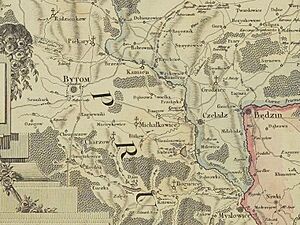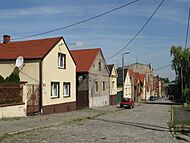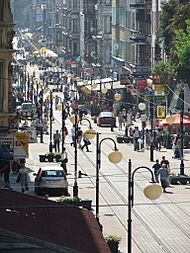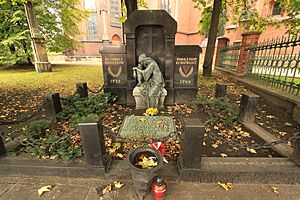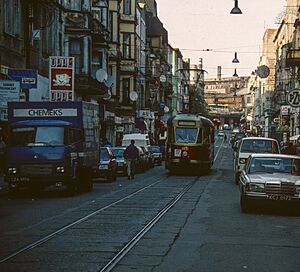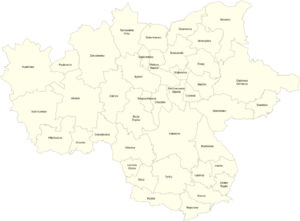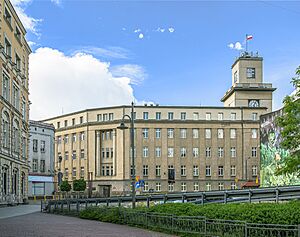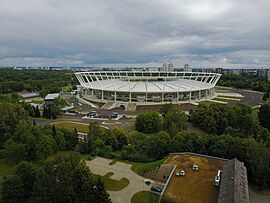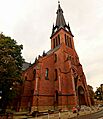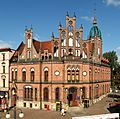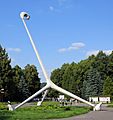Chorzów facts for kids
Quick facts for kids
Chorzów
Chorzōw (Silesian)
|
|||
|---|---|---|---|
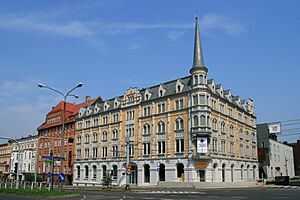
Teatr Rozrywki
|
|||
|
|||
| Country | |||
| Voivodeship | |||
| County | city county | ||
| Established | 1257 | ||
| City rights | 1868 | ||
| Area | |||
| • City | 33.24 km2 (12.83 sq mi) | ||
| Population
(31 December 2021)
|
|||
| • City | 105,628 |
||
| • Density | 3,166.9/km2 (8,202/sq mi) | ||
| • Urban | 2,746,000 | ||
| • Metro | 4,620,624 | ||
| Time zone | UTC+1 (CET) | ||
| • Summer (DST) | UTC+2 (CEST) | ||
| Postal code |
41–500 to 41–506
|
||
| Area code(s) | +48 32 | ||
| Car plates | SH | ||
| Primary airport | Katowice Airport | ||
| Website | https://chorzow.eu/ | ||
Chorzów is a city in southern Poland, close to Katowice. It's part of a large group of cities called the Metropolis GZM, which has about 2 million people. Chorzów is located in the Silesian Highlands, near the Rawa River.
Since 1999, Chorzów has been part of the Silesian Voivodeship. Before that, it was in the Katowice Voivodeship. Chorzów is one of the cities in the Katowice urban area, which has about 2.7 million people. The larger Katowice-Ostrava metropolitan area has about 5.3 million people. As of December 2021, about 105,628 people live in Chorzów.
Contents
History of Chorzów
How Chorzów Got Its Name
The city of Chorzów was created between 1934 and 1939. It was formed by joining four nearby towns: Chorzów, Królewska Huta, Nowe Hajduki, and Hajduki Wielkie. The name of the oldest settlement, Chorzów, was chosen for the new, bigger city.
No one is completely sure where the name Chorzów comes from. It might have been first mentioned as Zversov or Zuersov in 1136. Another old name, Coccham, was mentioned in 1198. Later, it was called Chareu in 1257 and Charzow in 1292. The name Charzow might come from the name Charz, which is short for Zachary. This would mean "Zachary's place." Today, the old village area is called Chorzów Stary, meaning "Old Chorzów."
A new town grew up around the Royal Coal Mine and Royal Iron Works starting in 1797. This town was called Królewska Huta in Polish or Königshütte in German. Both names mean "Royal Iron Works." This area grew quickly and became a city in 1868. Today, this part of the city is called Chorzów-Miasto, which means "Chorzów Centre."
The name Hajduki is also a bit of a mystery. It could be linked to a German word for "moorland" (a type of open land). Or it might come from a word for "bandits." This place was first mentioned in 1627 as Hejduk. Later, it was known as "Upper Heiduk" and "Lower Heiduk." The names Hajduki Wielkie and Nowe Hajduki mean "Great Hajduks" and "New Hajduks." These two settlements joined in 1903 and were named Bismarckhütte after the Bismarck Iron Works. Later, the name was changed to Batory after a Polish king. This part of the city is now called Chorzów-Batory.
Early History of the Village
In the 1100s, the area around Chorzów was part of Poland. In 1179, it became part of the Duchy of Opole. Since then, Chorzów's history has been connected to Upper Silesia.
The oldest part of the city, the village of Chorzów (now Chorzów Stary), belonged to a group called the Order of the Holy Sepulchre from 1257. Even back then, people mined silver, lead, and iron nearby.
From 1327, the rulers of Upper Silesia were part of the Piast dynasty. They were under the rule of the Kingdom of Bohemia. Later, in 1742, the area was taken over by the Prussians. This led to a time of fast industrial growth.
The Industrial Revolution in Chorzów
When coal was found in the late 1700s, new industries started in Chorzów. Between 1791 and 1797, the Royal Coal Mine was built. In 1799, the Royal Iron Works started making pig iron. This was a very advanced factory for its time in Europe. By 1819, the ironworks had four furnaces making 1,400 tons of pig-iron. Later, the modern Lidognia Zinc Works was also built.
Towns grew quickly around these new coal and iron factories. One town, Königshütte (or Królewska Huta), was named after the ironworks. In 1846, it got a railway track. By 1868, Królewska Huta became a city. Its population grew from 19,500 people in 1870 to 72,600 in 1910. Many people worked in the factories.
In 1871, the Royal Iron Works became part of a larger company. This company added a steel mill and other workshops. The Countess Laura Coal Mine opened in 1870. By 1913, it produced 1 million tons of coal each year. In 1898, a large power plant was built. It was the biggest in Poland until the 1930s. Today, it is called "ELCHO". In 1915, a chemical factory was built to make fertilizers and explosives. Today, it is called "Zakłady Azotowe SA."
Another ironworks, Bismarck Iron Works (later called Bathory Iron Works), opened in 1872. A large chemical plant was also built nearby in 1889. Today, this company is called "Zakłady Koksochemiczne Hajduki SA."
Towards the end of the 1800s, Polish national feelings grew stronger in Chorzów. People like Karol Miarka and Juliusz Ligoń worked to promote Polish culture and rights. In 1920, the famous football club Ruch Chorzów was started in the city.
Chorzów in Poland (1922–1939)
After World War I, a vote was held in Upper Silesia. Most people in Chorzów and Królewska Huta voted to stay with Germany. However, after some uprisings, the eastern part of Silesia, including Chorzów, became part of Poland in 1922.
In 1934, the towns of Chorzów, Królewska Huta, and Nowe Hajduki joined together to form one city with 81,000 people. The name Chorzów was chosen for this new city. In 1939, Hajduki Wielkie also joined Chorzów.
World War II (1939–1945)
In September 1939, at the start of World War II, Chorzów was taken over by Nazi Germany. Polish defenders tried to resist, but the city was occupied. Many Polish people were killed. A special German unit was in Chorzów and caused harm to Poles in the area. Polish property was taken, and Chorzów became part of German Silesia. The factories in Upper Silesia were very important for Germany's war efforts. In 1939 and 1940, many Polish teachers and other educated people were arrested. Some were killed in Chorzów or later in concentration camps.
During the war, there were several places in Chorzów where people were forced to work. This included camps for Poles and for Jewish people. From 1944 to 1945, there was also a subcamp of the Auschwitz concentration camp in Chorzów. About 200 Jewish people were held there. In January 1945, these prisoners were forced to walk to Gliwice and then sent to another camp. The Soviet Red Army took over Chorzów in January 1945.
After 1945
After World War II, Chorzów became part of Poland again. The factories in Chorzów were not badly damaged during the war. This helped Poland rebuild and grow its industries after the war. After the war, the factories became state-owned. Some were used as Soviet labor camps. In 1954, a sad event happened when 103 miners died in a coal mine accident.
On January 28, 2006, the roof of an exhibition hall collapsed, and 65 people died.
In 2007, Chorzów joined the Upper Silesian Metropolitan Union. This group of cities works together to improve the area and its infrastructure.
Over the years, many people have moved in and out of Chorzów. This includes people moving to Germany or from other parts of Poland and Ukraine.
Geography of Chorzów
Where is Chorzów?
Chorzów is in the middle of Poland's largest urban area. The Metropolis GZM is the biggest group of cities in Poland, with 2 million people.
Many important European cities are not too far from Chorzów. Six capital cities are within 600 kilometers (about 370 miles). These include Berlin, Vienna, Prague, Bratislava, Budapest, and Warsaw.
Chorzów's Climate
The average temperature in Chorzów is about 7.9°C (46.2°F) each year. The city gets about 723 millimeters (28.5 inches) of rain every year. Light winds usually blow from the west.
Chorzów's Population
Here's a look at the population of Chorzów as of December 31, 2021:
| Description | All | Women | Men | |||
|---|---|---|---|---|---|---|
| Unit | person | percentage | person | percentage | person | percentage |
| Population | 105268 | 100 | 55516 | 52.7% | 49752 | 47.3% |
| Population density | 3166.9 | 1670.1 | 1496.8 | |||
Chorzów's Economy
Chorzów used to be a very important city for industry in Poland. It had a lot of coal mining, steel production, chemical factories, and manufacturing. Over the last 20 years, many of these heavy industries have closed or become smaller. This is partly because of environmental concerns and a lack of new investments.
However, other industries have been updated and are still working. The city is changing from a heavy industry area to one with more services. The population has been getting smaller. Even though the unemployment rate has been high, it is going down. Many people in Chorzów have good technical skills.
Some of the main industrial places in Chorzów are:
- Huta Batory – makes steel
- Huta Kościuszko SA – also makes steel
- Chorzów Power Station – produces electricity
- Zakłady Chemiczne Hajduki SA – makes chemicals from coal
- Zakłady Azotowe SA – makes fertilizers and methanol
- Alstom-Konstal – makes trains, trams, and bridges
- KWK Polska Wirek, rejon Prezydent – a coal mine
- ProLogis – a logistics company (helps move and store goods)
- Messer – makes special gases for industry
Transport in Chorzów
By Car
- The A4 freeway connects Chorzów to cities like Wrocław and Kraków. It also goes towards Germany and Ukraine.
- The DTŚ is an express road that links Chorzów with Katowice and Zabrze.
- National Route DK79 connects Chorzów to Katowice and Bytom.
By Train
Chorzów has three railway stations on two main routes:
- One route goes from Katowice to Chorzów Batory and then to Gliwice.
- The other route goes from Katowice through Chorzów Batory, Chorzów Miasto, Chorzów Stary, and to Bytom.
By Air
- The main airport for Chorzów is Katowice International Airport.
Public Transport
Chorzów has good public transport with many bus and tram lines. The Silesian Interurbans is one of the biggest streetcar systems in the world. It has been running since 1894 and connects Chorzów to many other cities in the area.
There is also a metropolitan bicycle system called MetroBike. It has many stations and bicycles available for rent in Chorzów and nearby cities.
Higher Education in Chorzów
Chorzów has several places for higher education:
- The University of Silesia has two faculties (departments) here.
- WSB Merito Universities – WSB Merito University in Chorzów.
- Górnośląska Wyższa Szkoła Pedagogiczna (Upper-Silesian Teachers College).
- Górnośląska Wyższa Szkoła Przedsiębiorczości im. Karola Goduli (Karl Godulla Upper-Silesian Higher Business School).
- Śląska Wyższa Szkoła Informatyki (Silesian Higher School of Information Technology).
Chorzów also has many general and technical high schools.
The nearby cities of Katowice and Gliwice have even larger universities and colleges.
Places to See in Chorzów
Buildings and Architecture
- St Hedwig's Church
- St Barbara's Church
- Saint Mary Magdalene's Church
- Saint Mary's Church
- Saint Joseph's Church
- Main post office
- Municipal Savings Bank Building
Industrial History Sites
- Museum of metallurgy, located in the old power station of the Royal Iron Works.
- The Headframe of the closed President coal mine.
Silesian Central Park
The famous Silesian Central Park covers about 30% of Chorzów's area. It has many fun things to do:
- Silesian Zoological Garden – a zoo with many animals.
- Stadion Śląski – one of the biggest sports stadiums in Poland.
- Planetarium and Astronomical Observatory – where you can learn about stars and space.
- A large rose garden with 385 different kinds of roses.
- Legendia Theme Park – an amusement park.
- Upper Silesian Ethnographic Park – shows how people used to live in the region.
- International Exhibition Grounds – where big events and shows are held.
- A swimming pool complex.
- A water sports center.
- A tennis court complex.
- Lots of green areas for relaxing.
Chorzów also has other natural areas:
- The "Żabie Doły" nature area, which is shared with Bytom and Piekary Śląskie.
- The "Uroczysko Buczyna" nature area, shared with Katowice and Ruda Śląska.
- The "Amelung" water complex.
Sports in Chorzów
Chorzów is home to several sports clubs:
- Ruch Chorzów – a very successful men's football team. They have won the national championship 14 times and the Polish Cup 3 times. They also have a women's handball team that has won 9 national championships.
- Alba Echo Chorzów – a men's basketball team.
- SCS Sokół Chorzów – a women's volleyball team.
- Clearex Chorzów – a 5-player football team that has won the Polish Cup.
Stadion Śląski is a very important stadium. It used to be the home stadium for the Poland national football team. It hosts international football games and other big events. For example, it has held the Speedway World Championships four times. In 1973, over 120,000 people watched the World Final there, which is a world record for motorcycle speedway!
Since 2009, the stadium has also hosted track and field competitions. It is part of the World Athletics Continental Tour and the Diamond League series. In 2024, two new world records were set there in running and pole vaulting. The stadium also hosts huge music concerts with famous artists like The Rolling Stones, Metallica, and U2.
Famous People from Chorzów
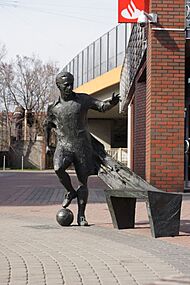
Born in Chorzów
- Kurt Alder (1902–1958) – a German chemist who won the Nobel Prize.
- Gerard Cieślik (1927–2013) – a famous Polish footballer.
- Marcin Dylla (born 1976) – a Polish classical guitarist.
- Olgierd Łukaszewicz (born 1946) – a Polish actor.
- Janusz Michallik (born 1966) – a former American national soccer player and now a commentator.
- Antoni Piechniczek (born 1942) – a Polish soccer coach who led the national team to the World Cup twice.
- Ryszard Riedel (1956–1994) – a blues rock singer.
- Hanna Schygulla (born 1943) – a German actress and singer.
- Franz Waxman (1906–1967) – an American composer.
Connected to Chorzów
- Friedrich Wilhelm von Reden (1752–1815) – a German pioneer in mining.
- John Baildon (1772–1846) – a Scottish pioneer in making metal.
- Adolph Menzel (1815–1905) – a German artist.
- Ignacy Mościcki (1867–1946) – a Polish chemist who became the President of Poland.
- Eugeniusz Kwiatkowski (1888–1974) – an important Polish economist and politician.
- Jerzy Buzek (born 1940) – a former Prime Minister of Poland and President of the European Parliament.
Chorzów's Sister Cities
Chorzów has special friendships with other cities around the world. These are called "sister cities":
Images for kids
See also
 In Spanish: Chorzów para niños
In Spanish: Chorzów para niños





